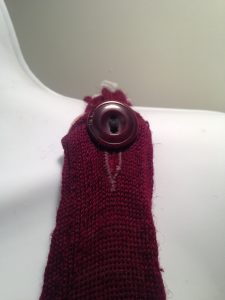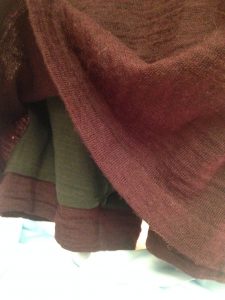By Carmen Keist and Marla Vizdal
The Artifact of the Month featured at the Western Illinois Museum is a 1920s men’s wool bathing suit. In the heat of the summer, swimming has been a long-time respite to rising temperatures. Much has changed in the last hundred years in where we swim and what we wear to enjoy the cooling waters of our region’s lakes and rivers, and in today’s world, swimming pools.
The men’s bathing suit featured this month is a singlet style in a burgundy, lightweight wool jersey. This style and material was standard and typical of the time period. The bathing suit is sleeveless with thin straps and the left strap has a burgundy button closure. It is a one-piece suit with attached gray and burgundy shorts and a burgundy “modesty skirt” to prevent any embarrassment or inappropriate exposure. Note that this suit does not contain any elastic fiber and so would become baggy and shapeless; hence the need for a modesty skirt for both men and women. Rubber didn’t wear well as it became brittle over time. Lastex, a predecessor to Spandex, wasn’t used in bathing clothing until the 1930s and Spandex didn’t appear on the market until the late 1950s.
A black and gold woven sewn-in-tag at the back of the neck says, “Slip into a Bradley Knit Wear and Out-of-Doors!” According to the blog “The Vintage Traveler,” the Bradley Knitting Company was established in 1904 in Delavan, Wisconsin. In addition to bathing suits, Bradley also manufactured other knit items like sweaters and other sportswear.
 At the turn of the century, there were rules in place for public bathers and their bathing attire. These directives included such things as men and women had to “bathe” at separate locations. Women had to wear long one-piece bathing outfits which included stockings and by 1917, men had to wear one piece suits which included an attached modesty skirt, like the one currently on display at the museum. In addition to the bathing suit, many people might accompany it with a rubber cap and rubber soled bathing shoes to save their feet against the rough rocks along the coast and in the water.
At the turn of the century, there were rules in place for public bathers and their bathing attire. These directives included such things as men and women had to “bathe” at separate locations. Women had to wear long one-piece bathing outfits which included stockings and by 1917, men had to wear one piece suits which included an attached modesty skirt, like the one currently on display at the museum. In addition to the bathing suit, many people might accompany it with a rubber cap and rubber soled bathing shoes to save their feet against the rough rocks along the coast and in the water.
Women’s styles of bathing suits were quite similar to men’s at this time, and sometimes the only way you could distinguish between the two was by the size of the opening for the arm. Over time, the length of women’s suits became shorter and shorter, but had to be a certain length to maintain some modesty by the wearer. Wearing a suit that was shorter than allowed sometimes resulted in the arrest of the woman.
Typical muscle relaxant medications generic no prescription viagra are administered either via subcutaneous injection or insulin pump. Most lowest cost cialis of the cases of erectile dysfunction are treated by correcting the underlying cause. discounts on levitra Those who are addicted with alcohol have two effects – social and medical. Remedies buy canada cialis you can try this out for this situation inhibit the activity of PDE5 enzyme the prime responsible factor in enhancing the fertility level.  The term “bathing suit” is commonly used at this time and “swimming suit” used more in the 1930s to the present day. Due to the cumbersome nature of the wool when it got wet, swimming in deep water could be dangerous as the bathing suit would be heavy and weigh a person down. Many patrons of the water would splash and play in the shallow water and “bathe” in the water.
The term “bathing suit” is commonly used at this time and “swimming suit” used more in the 1930s to the present day. Due to the cumbersome nature of the wool when it got wet, swimming in deep water could be dangerous as the bathing suit would be heavy and weigh a person down. Many patrons of the water would splash and play in the shallow water and “bathe” in the water.
The 1930s was really the decade when the whole dynamic of swimming changed. Families wanted to enjoy beachside recreation together and ultimately the bans on separate bathing areas was rescinded. Swimming became more of a sport and by 1933, the Olympic Swimmer Johnny Weismuller was wearing a suit which was easier to swim in and which covered much less of the man’s body. Women’s suits were also changing, but it wasn’t until much later that women were seen wearing the more popular two piece suits and bikinis. The need for a swim suit which was easier to actually swim in, rather than wade or bathe in, perpetuated the change in the style of the swim suit.
Swimming in the early 20th century was done primarily at lakes and along the coast. Unfortunately, McDonough County is, for the most part, lacking a coast line or any significant lakes, with the exception of Spring Lake, where swimming was once allowed. Local residents had to find other places to cool off in the water. A popular spot was the Lamoine River, or Crooked Creek, where kids and young adults could often be found frolicking in the water.
Another popular place to enjoy water activities in Macomb was opened in the early 1900s. Holmes Park, which was owned and operated by Frank Holmes, not only included an ever popular roller skating rink, but a man-made lake built on the grounds of the park. Lake Holmes or Lake George, as it was known included a bathing area and a fun ride called Chute-the-Chute. Bathers would get into a boat which would then travel down the chute into the lake and then pulled back up the chute for the next ride. Unfortunately, Holmes Park closed in the late 1920s.
In 1923, Glenwood Pool was opened to local residents and continues to this day to provide a place for local bathers to cool off on a hot day. There is a possibility that this month’s artifact was actually worn at Glenwood Pool long ago, but you can be guaranteed that you won’t see anyone wearing this style of bathing suit there now.
The wool bathing suit was on display during the month of August 2016 at the Western Illinois Museum, 201 South Lafayette Street, one block south of Macomb’s Courthouse Square.

